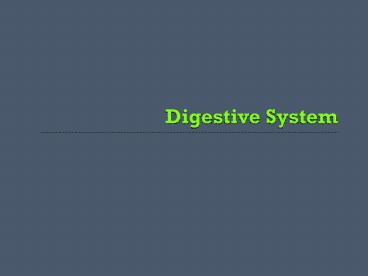Digestive System - PowerPoint PPT Presentation
1 / 15
Title:
Digestive System
Description:
Mechanical vs. Chemical Digestion. Chemical Digestion. Chemical breakdown of food into particles so small that they are able to be absorbed into the bloodstream and ... – PowerPoint PPT presentation
Number of Views:352
Avg rating:3.0/5.0
Title: Digestive System
1
Digestive System
2
Digestive System
- The digestive system can be divided into two
parts - Alimentary canal open ended muscular tube that
forms a digestive tract between the mouth and the
anus of an organism - Accessory organs organs which produce
secretions that assist in the digestive of food
food does not pass through these organs
3
Digestive System
4
Steps in the Digestive Process
- INGESTION
- The process of taking food into the body by the
mouth - DIGESTION
- The process of breaking food down into smaller
components - Two types of digestion
- a) Mechanical Digestion b) Chemical Digestion
5
Steps in the Digestive Process
- ABSORPTION
- Involves broken down food particles leaving the
digestive tract and moving to the blood transport
system - 80 of absorption occurs in the small intestine
- 20 of absorption occurs in the stomach and large
intestine - EGESTION
- Removal of solid waste (materials not absorbed by
the body)
6
Mechanical vs. Chemical Digestion
- Mechanical Digestion
- Physical breakdown of food into smaller parts (no
chemical change) - Involves primarily the MOUTH (biting, tearing,
grinding, chewing) and STOMACH (muscular
churning)
7
Mechanical vs. Chemical Digestion
- Chemical Digestion
- Chemical breakdown of food into particles so
small that they are able to be absorbed into the
bloodstream and into the cells of the body. - The chemical breakdown of food involves ENZYMES
and DIGESTIVE JUICES. - Enzyme protein that speeds up the rate of a
biological reaction without being used up in the
reaction
8
Major Parts of the Digestive System
- Mouth
- Aids in mechanical breakdown
- Releases enzymes for chemical digestion
- Releases saliva to soften food
- Easier to pass into esophagus
9
Major Parts of the Digestive System
- Esophagus
- Muscular tube connecting mouth to stomach
- Contains smooth muscle tissue
- Allows esophagus to relax and contract
- Contractions allow food to move along ?
peristalsis
10
Major Parts of the Digestive System
- The Stomach
- Main function ? to hold and churn food
- Stomach lining secretes digestive enzymes and
acids - Smooth muscle ? allows stomach to contract to mix
stomach contents
11
Major Parts of the Digestive System
- The Intestine
- Between stomach and anus
- Has cells that secrete mucus ? helps lubricate
food - Has lots of blood vessels interlaced through it
- allows nutrients to be absorbed into the blood
from the digesting food
12
Major Parts of the Digestive System
- The Intestine
- Small Intestine
- Approx 6 m long and narrow
- Most absorbing of food nutrients occurs here
- Large Intestine
- A.k.a. Colon
- 1.5 m long but bigger in diameter
- Most absorbing of water occurs here
- Remaining solid matter excreted as feces
13
Accessory Organs
- Liver
- Produces bile ? helps with digesting food
- Detoxifies substances in the body
- Pancreas
- Releases enzymes
- Important hormone released ? insulin
- Allows our cells to use the sugars we ingest
- Gallbladder
- Stores and releases acids to help in the
digestion of food
14
Accessory Organs
15
Homework
- Booklet Questions 1-6
- Answer 2 -5 on page 82
- Additional Question
- Describe what heart burn is. (Hint you can
find the info on page 81) - Study for circulatory and respiratory systems quiz































